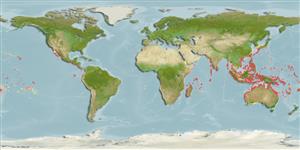>
Perciformes/Scorpaenoidei (Scorpionfishes) >
Scorpaenidae (Scorpionfishes or rockfishes) > Scorpaeninae
Etymology: Parascorpaena: Greek, para = near, in the side + Latin, scorpaena = a kind of fish, 1706 (Ref. 45335).
More on author: Peters.
Issue
Distribution of this species probably include those referring to Parascorpaena armata. Please send references.
Environment: milieu / climate zone / depth range / distribution range
Ökologie
seewasser riff-verbunden; tiefenbereich 0 - 18 m (Ref. 9710). Tropical
Indo-Pacific: East Africa to the Society Islands, north to Izu Islands, south to Australia; throughout Micronesia (Ref. 1602). Specimens from the Pacific Ocean, currently
regarded as P. mossambica, are most likely to be P. armata (H. Motomura, unpubl. data). The name, P. mossambica., remains valid for specimens from the Indian Ocean (Ref. 86966).
Size / Gewicht / Alter
Maturity: Lm ? range ? - ? cm
Max length : 12.0 cm TL Männchen/unbestimmt; (Ref. 90102)
Rückenflossenstacheln (insgesamt): 12; Rückenflossenweichstrahlen (insgesamt): 9; Afterflossenstacheln 3; Afterflossenweichstrahlen: 5. Supraocular tentacles well developed (Ref. 37816, 48635).
Inhabits areas with mixed sand and rubble in reef flats, shallow lagoons, and channels. Hides during the day, ventures out in the open at night. Anterolateral glandular groove with venom gland (Ref. 57406). Solitary (Ref 90102).
Life cycle and mating behavior
Geschlechtsreife | Fortpflanzung | Ablaichen | Eier | Fecundity | Larven
Myers, R.F., 1991. Micronesian reef fishes. Second Ed. Coral Graphics, Barrigada, Guam. 298 p. (Ref. 1602)
IUCN Rote Liste Status (Ref. 130435)
Nutzung durch Menschen
Mehr Information
NamenSynonymeMetabolismusRäuberÖkotoxikologieFortpflanzungGeschlechtsreifeAblaichenSpawning aggregationFecundityEierEientwicklung
ReferenzenAquakulturAquakultur ProfilZuchtlinienGenetikElectrophoresesVererbbarkeitKrankheitenVerarbeitungNutrientsMass conversion
Tools
Zusatzinformationen
Download XML
Internet Quellen
Estimates based on models
Preferred temperature (Ref.
123201): 24.3 - 29.3, mean 28.4 °C (based on 2873 cells).
Phylogenetic diversity index (Ref.
82804): PD
50 = 0.5078 [Uniqueness, from 0.5 = low to 2.0 = high].
Bayesian length-weight: a=0.01259 (0.00606 - 0.02615), b=3.03 (2.86 - 3.20), in cm total length, based on LWR estimates for this (Sub)family-body shape (Ref.
93245).
Trophic level (Ref.
69278): 3.6 ±0.6 se; based on size and trophs of closest relatives
Widerstandsfähigkeit (Ref.
120179): hoch, Verdopplung der Population dauert weniger als 15 Monate. (Preliminary K or Fecundity.).
Fishing Vulnerability (Ref.
59153): Low vulnerability (10 of 100).
Nutrients (Ref.
124155): Calcium = 101 [51, 235] mg/100g; Iron = 0.734 [0.366, 1.961] mg/100g; Protein = 18.2 [16.3, 20.2] %; Omega3 = 0.226 [0.095, 0.624] g/100g; Selenium = 20 [10, 51] μg/100g; VitaminA = 183 [60, 527] μg/100g; Zinc = 1.63 [1.09, 2.40] mg/100g (wet weight);
